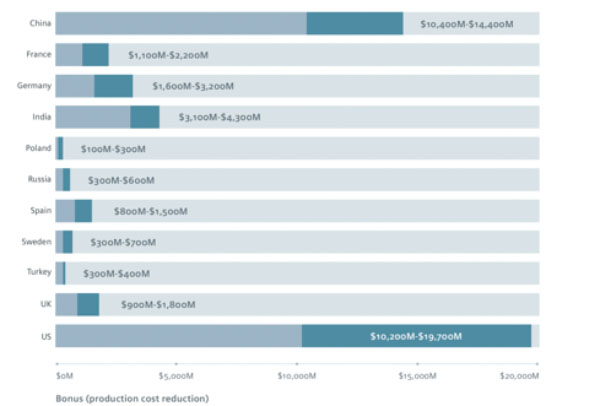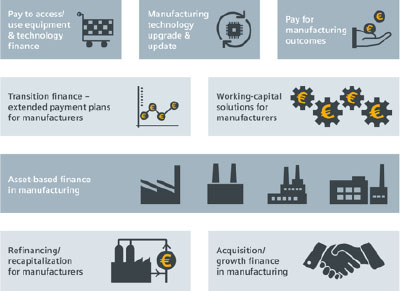In the pharmaceutical sector, for example, digitalisation and data analytics can reduce the high levels of downtime typically experienced by pharmaceutical plants. Although, the various dimensions of productivity differ between industries and countries, increased manufacturing productivity — the ability to either produce the same number of products for less or more products for the same — has a clear and calculable positive effect on costs and margins.
This effect — which we have called the Digitalisation Productivity Bonus (DPB) — is the focus of our latest research, which captures testimony from more than 60 international industrial companies, expert management consultancies and academic specialists based in 11 countries. The resulting model estimates the DPB for different industries. The potential global DPB (all manufacturing sectors) is estimated to be between 6.3 and 9.8% of total annual revenue by 2025.
Additionally, the research looks specifically at the potential gains for the pharmaceutical manufacturing industry. Applying the model to this sector in each of 11 countries provides an estimate of the DPB to be gained as a result of investment in digitalised Industry 4.0 technology.1
The resulting totals are an estimate of the potential financial gain for the pharmaceutical industry as a direct result of improvements in manufacturing productivity from digital transformation. In the global pharmaceutical manufacturing industry, it is estimated that conversion to digitalised technology could deliver a DPB of between $67 and $105 billion (Figure 1).2

Figure 1: Estimated DPB: reduced production costs resulting from conversion to digitalised technology in the pharmaceutical industry
The DPB is a critical starting point for CFOs in the pharmaceutical industry. Nevertheless, there are other commercial benefits to be accrued from the move to digitalization. Pharmaceutical plants typically experience high levels of downtime. According to one analyst, digitalisation and data analytics could reduce this by 30–40%, significantly improving overall equipment effectiveness (OEE).3
Internet of Things (IoT) communication between machines and machine-learning artificial intelligence (AI) deliver seamless processes, predictive maintenance and automatic corrective actions.
Added value
The pharmaceutical manufacturing environment is highly sensitive and tightly regulated. The smallest of errors can result in life-changing patient outcomes and have a disastrous commercial, legal and reputational impact on the manufacturer. For these reasons, “Pharma 4.0” can often deliver amplified operational and competitive value.
A few years ago, a global pharmaceutical giant had to recall more than a half a million tablets because of packaging and human-monitoring errors in the plant. Digitalisation and automation are now ensuring the company will not experience a similar error in the future and suffer the financial ramifications and negative brand impact it suffered in the past.
The company has introduced digital sensors and robotics and invested in high-availability computing to guard against data transfer issues between units. This has created a fully automated production line that has the by-product benefits of making it much easier to maintain cleanroom processes, capture and manage electronic batch records, and analyse process performance (through root-cause analysis) to identify and implement improvements.
Further points of value for Pharma 4.0 are being gained in the field of regulatory compliance. One manufacturer has installed digital sensors for visual, environmental, temperature and chemical monitoring throughout its manufacturing process. This has now automated compliance reporting that previously involved expensive manual monitoring, although half-yearly manual tests are still made by an outside agency to audit and verify the automated reporting.
Not only has this released crucial funds for investment elsewhere in the business, it has also provided the means for alerts when any of these factors move outside defined tolerances, triggering early intervention that minimises the cost of potential contamination, formulation errors and consequent process shutdowns.
Mass customisation is also important to the pharmaceutical sector in light of the increasing trend of individualised formulations.
Although individualised medication manufacturing raises important issues about quality, batch stability and risk management, some areas may benefit from being able to manufacture short runs of customised therapies at the kind of price previously associated with mass production. One manufacturer is currently trialling such digitalised processes with analgesic combinations.
Beyond manufacturing
Digital integration of the distribution chain (through distributors, then pharmacists and retailers, to the clinician and patient) offers pharmaceutical companies greater opportunities to combat fraud. One generics manufacturer became aware of several counterfeit versions of its products in certain countries.
The company introduced an encrypted digital signature to its packaging that allowed genuine products to be tracked and traced down the distribution chain, with healthcare organisations able to verify the product through a secure portal in the cloud.
Digital information integration up the supply chain and down the distribution chain is also delivering greatly enhanced demand-supply management. One manufacturer that supplies a wide range of therapies has set up information links with all the hospitals in a single particular location. Links to these hospitals’ clinical information systems enables the gathering of aggregated anonymised patient data in a selection of specialties and uses predictive analytics to better plan manufacturing production volumes. This pilot has already demonstrated high levels of accuracy and is planned for gradual rollout across the country through to 2020.

Examples of Industry 4.0 Finance
While digitalisation drives financial sustainability, access to a range of smart and appropriate financing techniques — Industry 4.0 Finance — is also critical to a company’s ability to sustainably invest in the new fourth-generation of digitalised technology and automation equipment. Industry 4.0 finance covers a range of requirements from the acquisition of a single digitalised piece of equipment, right through to financing a whole new factory.
Financing techniques have now been developed to allow an organisation to in effect apply some or all of the DPB to fund the digitalised technology and equipment that makes the bonus possible in the first place. In simple terms, these financing methods seek to align payments for the new generation technology with the rate of gain from the DPB. Broadly speaking, this can help make the upgrade to digitalised technology affordable and potentially cost neutral (or better) for the manufacturer.
Industry 4.0 Finance arrangements tend to be offered by specialist providers that have a deep understanding not only of how the digitalised technology works, but also of how that technology can be practically implemented to deliver the DPB as well as other benefits. At times, the financing arrangement will be an embedded component of the value proposition, offered right at the beginning of the sales cycle. In other cases, the technology provider will refer its customer to one or more finance providers to fund a sale.
Complete solutions should be taken into consideration to identify the best finance package to effectively digitalise a manufacturing facility’s entire operation — from equipment to software to the production line to the whole enterprise. Between them, this range of Industry 4.0 Finance techniques allows pharmaceutical manufacturers to access the DPB.
References
1. The average bonus percentage range has been applied to the total annual revenue of the pharmaceutical industry in selected countries across the globe (official data on revenue was taken from official third-party sources).
2. Average DPB data derived from more than 60 interviews in 11 countries with international manufacturers, international management consultancies and academic experts (expressed as a percentage of total revenues).
3. www.strategyand.pwc.com/reports/digitization-in-pharma.




